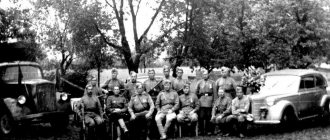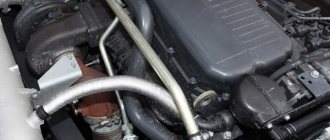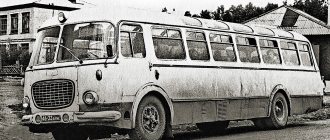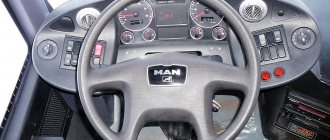Test drive Volkswagen Transporter T1: the face of the hippie era
The Transporter's deceptive appearance
Perhaps, our age of total consumption was still able to finish off the little personal that could still be found in cars of the middle of the last century.
To monitor engine speed, we look at the tachometer, because most motorists now perceive the sound of the engine in the cabin as absolute evil. We evaluate the performance of automatic transmissions by how imperceptibly the moment of gear shift flies past us. We even trust the gas station attendant to fill up with gasoline, and few people now remember that the O-ring for the needle of the carburetor float valve could be obtained from a disposable Chinese lighter. When looking at the Transporter, in the depths of our souls, a feeling of guilt appears that the car has become for us nothing more than a thing that can only be driven and, at any opportunity, exchanged for a new one. His round kind headlights say: “Hey, friend, let's go for a ride! I miss you, buddy." However, for now, let’s put aside the irresistible desire to hug the bus and walk around it.
The Germans did not live well after the war, but they did not spare material for the VW emblem. Five years have passed since the signing of the surrender agreement, so they apparently began to forget about modesty. But direction indicators of the same impressive size appeared not with the start of Volkswagen production in 1950, but later. Originally there weren't any, but our 1966 car has them, as does the air intake above the windshield. The “lobovukha” itself traditionally tilts upward. In general, it’s easy to ventilate the car: a folding windshield, a ventilation system with adjustable air flow direction over the heads of the driver and passenger, many windows (23 glasses were installed in some trim levels), and even a hatch. But there is no stove. Considering that the air-cooled engine is in the rear, there is nothing to heat the interior with at all. All this suggests that this minibus was not intended to be exported to countries with cold climates (well, you get the idea!), unlike, for example, Brazil, where the conveyor belt of the local plant left the Transporter only eight years after the end of production in Germany .
The rear lights of our car are also larger than those on the T1 of the first years of production. Moreover, they are also completely red, because the current owner of the Volkswagen brought it not from Europe, but from America, where these cars today are much cheaper and easier to find than in Germany. However, the differences between the export car and the one for the domestic market are minimal: in addition to the red turn indicators, there is a speedometer marked in miles, and the inscription “tank” on the fuel level indicator. Everything else is absolutely the same. There were also cars for Sweden, where left-hand traffic was replaced by right-hand traffic, the last in Europe. These Transporters had a steering wheel on the right, but in order to reduce production costs, the passenger doors remained on the right.
1 / 4
2 / 4
3 / 4
4 / 4
In general, the T1 Transporter expresses the concept of a “people's car” in the best possible way. There is not much here: design delights, advanced technical solutions, expensive options... But at the same time, this is a German car, so everything is done with high quality, thoughtfully and even with some playful touches on comfort. The swing as a whole was not a success, but the windshield wiper has an electric drive, the interior has a dome light, the instrument panel has a tiny ashtray, and at the feet there are not rubber mats, but a homely carpet, impractical, but pleasing to the eye. There are even rubber bumpers on the doors, which prevent the side of the minivan from being scratched when opened. Let us note once again: the absence of tons of chrome and other decorative elements does not spoil the appearance of the Transporter at all. He is modest, but neat, as befits a neat burgher.
Inside Transporter T1
The laconicism of the dashboard is simply phenomenal. There are only two instruments: fuel level and speedometer. In the window of the latter there are three tiny warning lights: oil pressure, light indicator and ignition indicator. The set of controls is also minimal: a steering column turn signal switch, a central light switch, a wiper switch, a gearshift lever, a handbrake and a steering wheel, of course. There is nothing else to switch here due to the simplicity of the design. But under the driver’s seat there is a reserve fuel supply lever in case of shortage. Although it would be more logical to install a lever with which the amount of this fuel could be reduced, as we will see during the trip.
1 / 3
2 / 3
3 / 3
But we can only rejoice at the ventilation system! There is a damper control lever at the feet, and on the ceiling there is a whole block with a bunch of flow direction adjustments. I don’t want to twist it, especially if there is nothing else to twist. Although our car also has a radio - it’s similar to the original only in appearance, but it’s still there. Believe me, for T1 this is already quite serious additional equipment.
Earlier cars had even more meager equipment. There were no turn signals, radio, decent ventilation system, fuel level indicator, and a bored passenger could only be entertained by opening and closing the windows, fortunately there were many of them. In 1961, the driver received a separate seat with longitudinal adjustment and a fuel level indicator. I sat down on just such a separate seat. It has a very short cushion, and there is also a significant downward slope, which makes landing in T1 a little more comfortable than landing on a stake. The upper frame of the windshield is located slightly above eye level, and it is very intrusive for taller drivers. There is a good way out: lie down on the almost horizontal steering wheel and relax. Then it’s harder to fall out of the seat, and the visibility is better. You can’t exert yourself at all in this car, apparently, that’s why the “flower children” loved it so much, eager to make love, not war, to the songs of John Lennon and Scott McKenzie. Sitting behind the wheel, I fought the urge to put on a dozen baubles and a vest painted in the Flower Power style.
And during the trip, I was uncontrollably drawn to do something else that would pull me to the station. 6, clause 9 of the Code of Administrative Offenses of the Russian Federation. Because otherwise the car just drives you crazy.
1 / 4
2 / 4
3 / 4
4 / 4
Let's start with the fact that for some reason Volkswagen engineers decided to install an automatic choke in the carburetor, something like a “choke”, but which works on its own, without obeying the driver, and with a behavior algorithm as logical as the jumping of a grasshopper. The owner of the minivan changed several of these devices during the restoration process, but they all work equally unpredictably and generally... nothing at all. Therefore, overfilling gasoline is a common thing, hence the popping noises in the exhaust system: excess gasoline has nowhere to go but burn out with the corresponding sound. A more unpleasant moment is when a cold engine refuses to start. The situation is complicated by the fact that only God knows when and in what position this mechanism will jam. However, it can sometimes work as expected. But this is rather an exception. For comparison, in the Zhuk, which had almost the same engine, manual control of the “choke” was provided. He is not here, which sometimes causes slight indignation.
Driving a hippymobile
As in any other car from the middle of the last century, the engine can be heard well. Even too much, given its rear location, the size of the Transporter and the 36 “horses” in its four-cylinder “stall”. But this is not so scary - the trouble begins when searching for first gear. The knob of the gearshift lever (despite its decent length) sticks out somewhere below, you have to reach for it. Then swing around the cabin looking for a transmission. The switches are indistinct, like pension reforms. In fact, they are located quite close, but the giant free play of the lever makes searching for a gear as exciting as hunting for a lonely annoying mosquito in the dark of the night. The transmission is there somewhere, but you need to look for it quickly, carefully and methodically. Of course, after a few starts you get used to it, but a residue remains.
The acceleration of the car is pleasing. At low speeds it has the unexpected agility of a young saiga, so even in city traffic you don’t feel too handicapped. Very well-chosen gear ratios of the box and the presence of wheel gearboxes have an effect. Therefore, even with a low-power engine up to 30 miles per hour (that’s a little less than 50 km/h), one could drive quite calmly, if not for one “but”. The fact is that this car handles a little worse than a loaded barge on the Volga. In order to stay on the lane, you have to turn the steering wheel back and forth, but without turning it too much, because the car begins to tack like Christopher Columbus's sailing ship. A very exciting activity, considering that it is generally not difficult to accurately enter a turn if you slow down in time. The light weight of the minivan, its narrow track and high side make it “sail” in a side wind, and in a headwind it barely moves. Under favorable weather conditions, I repeat, the dynamics are surprisingly good. The main thing while driving it is not to be nervous. A headwind blew and the car stopped - calm down; walks in a straight line left and right - don’t worry. On T1 you need to drive relaxed, like any decent hippie. We, of course, know the secret of their calm, but we are firmly against this method. Therefore, we exhale, lie down on the steering wheel and drive along the avenue.
A little about technology
Let's start with the fact that, by and large, the Volkswagen Transporter T1 is the founder of not only the glorious line of all Transporters of this brand, but also the class of minivans as a whole. And his concept was invented completely by accident: the Dutch entrepreneur Ben Pont, who imports Volkswagens to the Netherlands, was once walking through the VW factory floor, and he came across a car assembled by workers from the Beetle and used by them to transport goods between the workshop buildings. The observant businessman thought for a while, then pulled out a notebook and sketched a sketch of a car that, in his opinion, would be in demand in post-war Europe. His drawing was approved by Heinrich Nordhoff, the company's CEO. This happened in 1947, and two years later the first T1 sample appeared. It inherited the transmission from the VW Beetle, the power of the 1.1-liter engine was only 24 hp, and the electrical equipment was six volt. In 1950, the car went into production. In 1960, the power of 1.2-liter boxer engines increased to 34 hp, and the gearbox became fully synchronized. A year later, they began to install a fuel level indicator, a reserve fuel lever under the seat and a separate driver's seat. And finally, in 1965, the electrical equipment became 12-volt, and the engine gained a couple more horsepower. This is exactly the car we had for a test drive.
We have already mentioned the main design features: automatic suction and wheel gears. All other systems were dispensed with without any innovative solutions, which made it possible to make the car inexpensive and easy to operate. The service life of an air-cooled engine is traditionally not high, but also not as short as that of our Zaporozhets. The peculiarity of their repair was that the cylinder-piston group was replaced as an assembly. Repair kits for CPGs with a volume increased to 1.6 liters were also on sale. The whole alteration boiled down to replacing the cylinder along with the piston, which was quite simple to do. The ease of maintenance and repair, coupled with the low cost of the car and the relatively comfortable interior at that time, were liked not only in Germany, but also in the USA and many other countries, including South America. In the USSR, and then in Russia, such cars were rare. Firstly, this is a foreign car with all the ensuing consequences in the form of a lack of spare parts, and secondly, the T1 is absolutely not suitable for operation in cold climatic conditions. Its other drawback, according to the Russian people, was its absolute intolerance to overload. But there are such cars abroad, and they can be found even in good condition. As we have already said, this car was brought from America, more precisely, from the southern part of it, so it did not cost too much, and the condition of its body was not bad. For a Transporter that requires restoration, the condition of the body is an important factor due to its rather complex supporting structure with a base in the form of a multi-link frame. But in general, spare parts can always be found; fortunately, they can be ordered in Europe now.
1 / 3
2 / 3
3 / 3
In general, the car has become extremely popular both at home and overseas. At that time, it had no analogues in terms of price-quality ratio, and the revolutionary form factor at that time played its role. The car digests 92 gasoline surprisingly well. True, the appetite is not small, but what can you do: the engine has to be cranked, especially under load. But you can still drive this car today, the main thing is to find a company of like-minded “hippies.” The main thing is to steer very carefully. And don't be nervous. For a car that has become iconic for the era of “expansion of consciousness” lovers, this is the main thing. Don't worry, Be happy, no other way!
Modifications
- Flatbed truck with simple cab
- Flatbed truck with double cab
- Minibuses with or without three additional windows on each side
- Minibus with up to nine seats, including the driver (13 windows, including windows in the doors)
- SambaBUS
- Special vehicles (ambulance, police, etc.)
- Cars with high roof
1966 Volkswagen Type 2 T1 1.5 l / 42 hp Moscow registration, PTS, license plates, 100% customs, after restoration.
Price: 2,459,000
auto.ru











